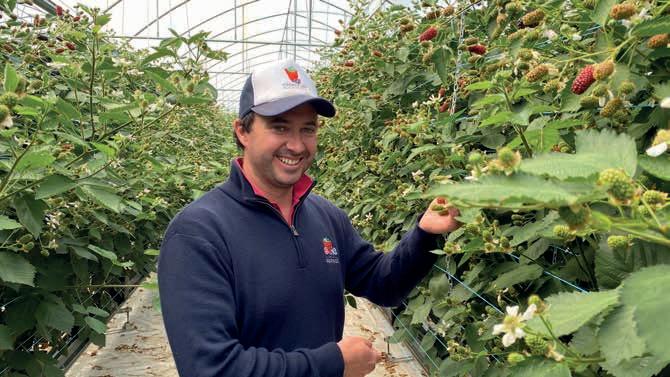
8 minute read
European hothouse design delivers blackberry powerhouse for Tasmanian Berries
Jane Richter & Mark Salter, Berries Australia
On the recent Berries Australia team visit to Tasmania, Jane and Mark were lucky to be invited to Tasmanian Berries to see the new twin 2.5ha hybrid-hothouses built based on a unique design idea that owner Andrew Terry first saw in Kent, UK a few years ago. There are no other hothouses like this in Australia, and Andrew provided us with an extensive tour whilst sharing his experiences and observations about the performance of the new structures growing Blackberries.
Tasmanian Berries is based across two sites in central northern Tasmania and currently grows strawberries, raspberries and blackberries. All the berry crops are grown under a protected cropping set-up, with nearly all plantings in coir managed by a state-of-the-art irrigation and nutrient management system.
The farm has 25 hectares of single tabletop strawberries all grown in coir in polytunnels with all the varieties grown coming from the Driscoll’s stable. There are 11 hectares of raspberries and 10 hectares of blackberries in traditional polytunnels, as well as a number of small trial areas looking at new genetics and other special projects including a raspberry and blueberry nursery. Tasmanian Berries are also developing a third site at Bundaberg in Queensland, known as Sunshine Berries, where they have a further six hectares of raspberries and six hectares of blackberries in a hothouse and under polytunnels.
In 2022, Tasmanian Berries commenced construction of two, 2.5-hectare gothic styled polyhouses for blackberry production. The hothouses are made of dual layered polythene separated by an air layer. Inside there are blowers spread throughout the 5ha which take the air from inside the hot house and blow it into the air gap to create the thermal break.
The entire roof of the structure has this feature which delivers better temperature management across the season, holding heat in during the shoulders of the season to extend the cropping window and reducing the heat build-up during the summer months. There is currently no need to add any additional heating as the coolest period of the year falls in line with the plants ‘off-season’.
The design also features a series of fans which manage the humidity levels throughout the hothouse and will come on automatically based on live sensor data to ensure there are no pockets of moist air sitting in sections of the structure. A rack and pinion system connecting the roof vents enables these to be adjusted in response to the sensed conditions inside and outside of the hothouse structures, all managed via an automated management system.
The hothouse design is from Spanish company Novagric (Novedades Agricolas) and the automated management system is from Dutch company Priva. The rest of the farm currently uses Priva technology, so it made sense to retain a commonality of technology in the new hothouses.
We probably gain 6-7 weeks at the start of the season and then we can get an extra two months out of the season at the back end,” explains Andrew. “With only twelve months in the year, it’s a fine balance between maximising the productive cropping window and ensuring that there is enough time to turn the crop back over with the pruning and winter chilling required.”
In the existing standard polytunnels, production of the blackberry crop traditionally commences in late December and finishes in early March. In the new hothouse system, production is able to be extended; commencing in early November until mid-January and using the same plants in the same season, a second crop produces from early April until mid-June.
The traditional yield for blackberries is about 20-25 tons per hectare, but in this hybrid hothouse model, Andrew is estimating they will pull anything up to 50 tons per hectare each year. Overseas models have reported up to 60-70 tons per hectare using this style of production system, but Andrew is realistic and understands there will be teething challenges and continual refinements that will gradually improve yield over time.
Some of those challenges have been controlling the temperature of the hothouses in summertime. In the first year, Andrew made the decision to aerial spray chalk over the roofs of the hothouses to reduce the internal temperature. The outcome was beneficial, reducing the daily temperatures by up to four or five degrees, which in turn ensured better plant health for the second harvest. In 2023, further modifications were made to the structures, by creating side vents to generate better airflow for temperature control and pollination.
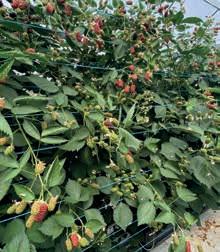
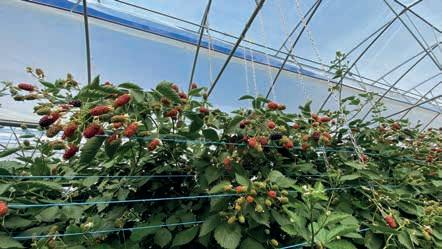
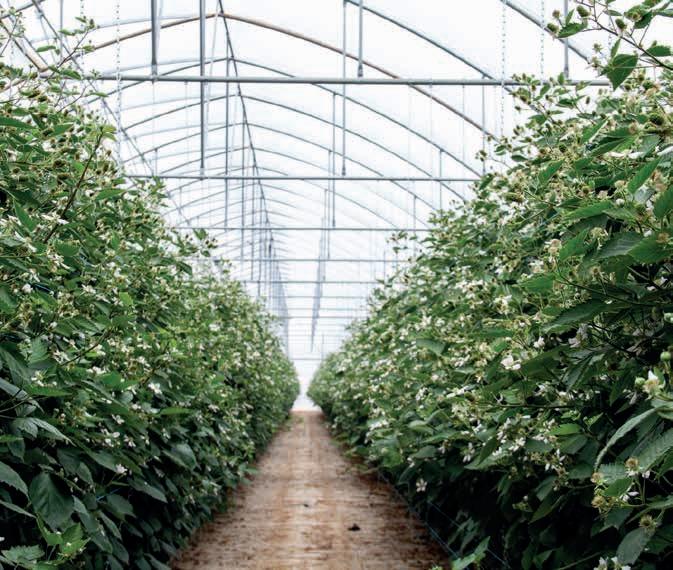
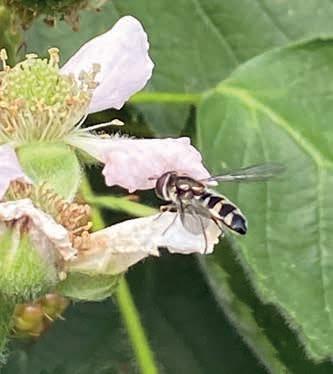
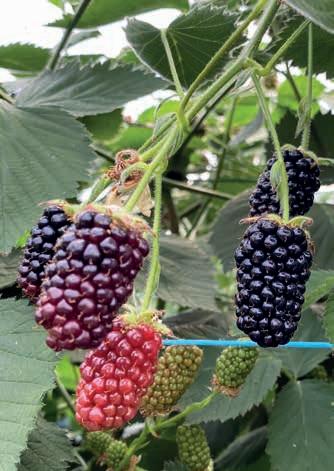

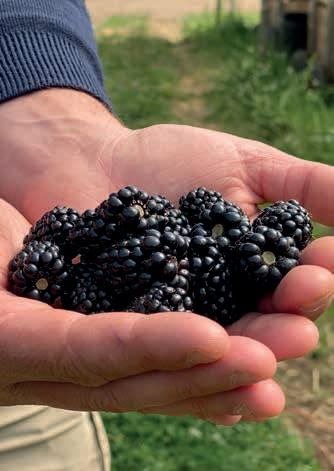
There are some distinct advantages to this new system over standard polytunnels that the team have noted. There is practically zero weed ingress so chemical use for weed control is simply not required.
You get such amazing lateral extension,” says Andrew, “and we get a greater breakback on the laterals with 4 to 5 nodes instead of 3 to 4 nodes sprouting which gives you additional yield.
One major challenge is pollination. The hybrid hothouse is fully enclosed with relatively small doors at the corners and on both long sides only. There are roof vents across the roof and in the first season the team installed the netting that was supplied with the system from Europe, designed to stop Spotted Wing Drosophila flies from entering, but this only served to impede the flow of pollinators into the modules. The netting has been removed and pollination rates have improved. The European honeybees kept on site in hives can now access the hothouse through the roof vents and the team have supplemented that with some manual canopy shaking to improve overall pollination success. There are also small levels of other pollinators like hoverflies operating inside the hothouses.
There are also some advantages noted in the harvesting process. The first harvest off the long cane is very ‘peaky’ in that most of the fruit is ripe and ready at once. This creates about a 20% picking efficiency boost as more fruit can be picked per hour, reducing the harvest costs.
The berries are large and the pack-out rate is much higher than the standard polytunnels with much lower wastage due to less damage like wind-rub occurring on the fruit. The ground is very flat and even inside the hothouse making it easier for pickers to move up and down the rows, and the picking trolleys feature built-in steps to enable access to the high growing berries.
Spraying inside the hothouses looks a little different to polytunnel or open field operations. The team have a small rig for spray applications and the operator dons a slightly space-age looking fully enclosed air-conditioned suit for safe operation in the relatively enclosed area. With the interior design of the hothouse and the height that the plants reach when in full growth, there may need to be some adjustments to the spray shrouds, but this is one of the tweaks the team can make after a full season of experience is under their belt.
When we entered the hothouse, the first observation was that the canes were absolutely fully laden with flowers and developing berries. The design of the trellising system layers the fruit out from the centre enabling the pickers to easily access the berries. It’s also here amongst the rows that you can see the additional growth and break-back from the laterals that creates the heavy fruit load that Andrew described earlier.
The system has required a considerable investment in time and money, and Andrew has completed this without any grants or secondary funding, but the yield benefits alone will result in a relatively short payback period and boost the supply window for high-quality blackberries in Australia. From the initial idea to completion of the build and full planting it has taken nearly 3.5 years. Andrew has been fortunate to have a UK berry grower installing a similar system around the same time that he has been able to share ideas and ask questions of. This season is the first full production with the infrastructure completed and planted out. The variety grown is Driscoll’s ‘Victoria’ and the fruit are extraordinarily large and dark purple when ripe. All the fruit are marketed under the Driscoll’s brand with much of it sold in their new premium branding.



